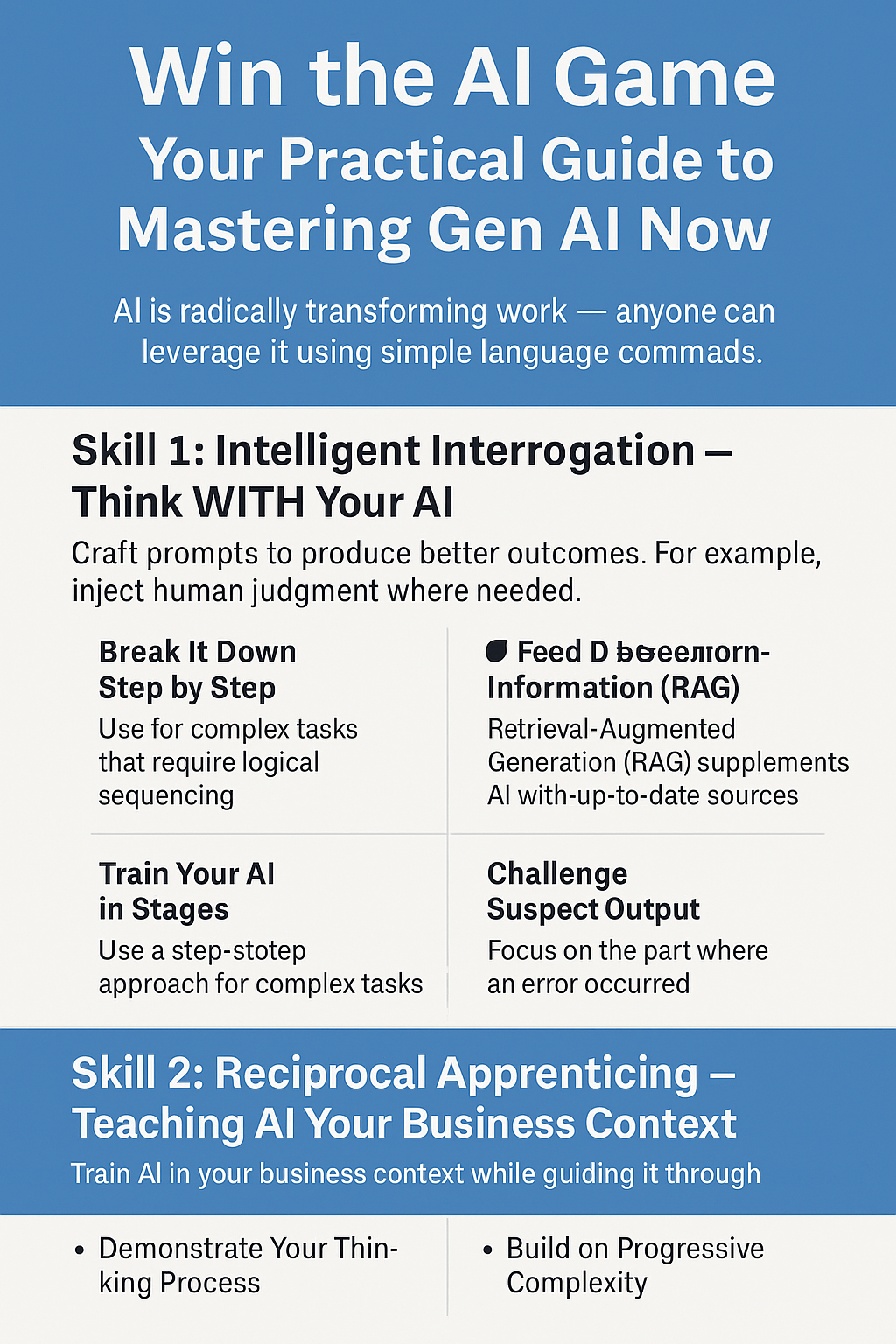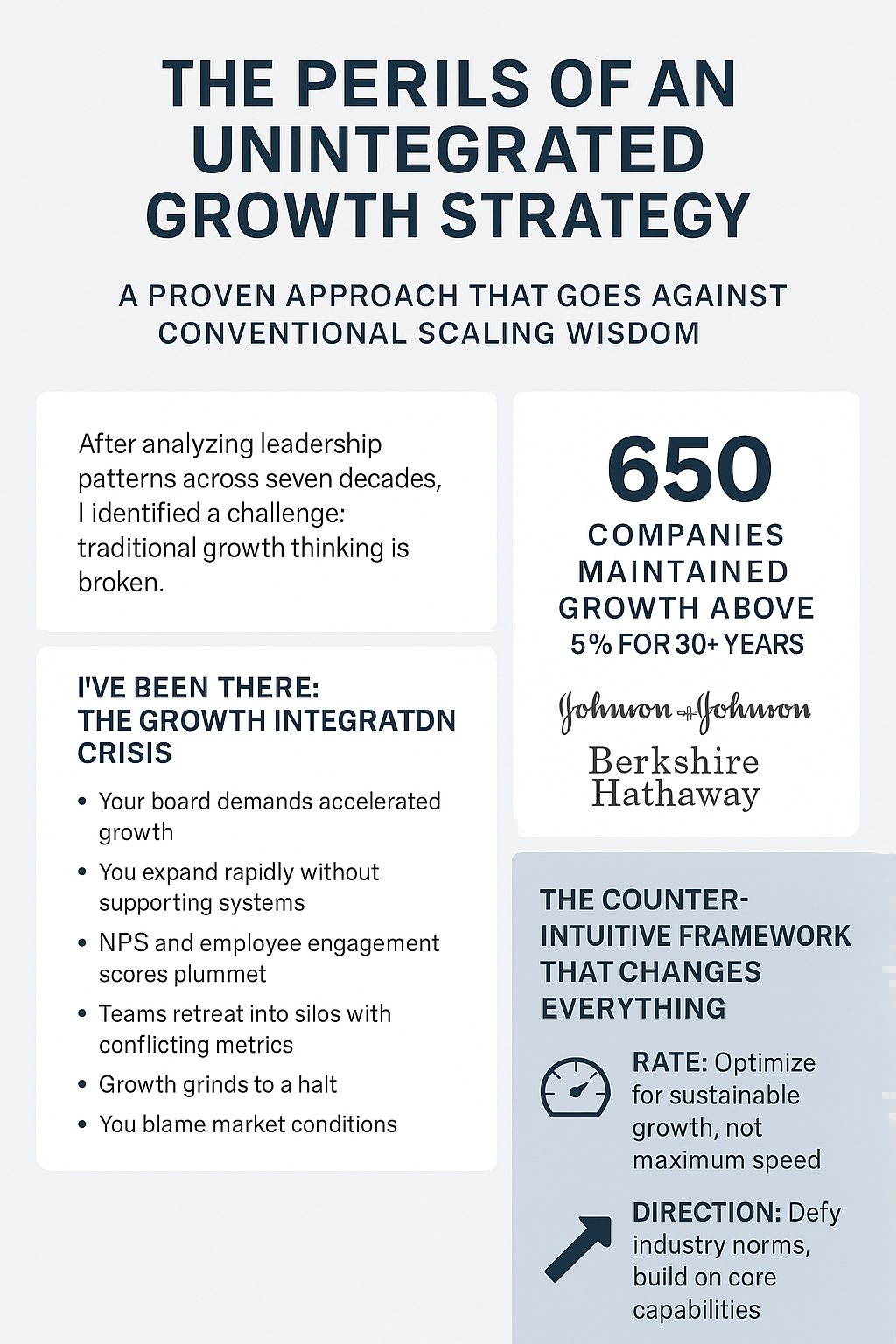Win the AI Game: Your Practical Guide to Mastering Gen AI Now

Look, let’s cut to the chase. AI is no longer coming—it’s here, radically transforming how we work. And make no mistake, this isn’t just for tech folks. Anyone can leverage AI today using simple language commands instead of code. My team’s research confirms what I’ve seen firsthand: over 40% of U.S. work activity can be […]
The Perils of an Unintegrated Growth Strategy

Why 99% of Companies Fail at Sustainable Growth: The Integration Crisis Nobody Talks About
Discover the counter-intuitive growth framework that helped scale companies from zero to $500M+ while maintaining profitability
After analyzing 11,000 companies across seven decades, a shocking pattern emerged: only 650 maintained growth above 5% for over 30 years. The culprit? A hidden “organizational debt” that sabotages even the most promising growth strategies.
In this data-driven analysis, learn:
Why maximum growth speed actually destroys company value (with real metrics from New Relic and Web.com transformations)
The 3 critical KPIs that predict growth failure before it shows in financial results
The RDM framework that contradicts conventional scaling wisdom but delivers 3x higher profit per location
4 specific actions senior leaders can implement this quarter to build sustainable growth
Drawing from experience leading growth at multiple $1B+ companies through 35+ M&As, this article reveals why companies that deliberately slow growth during uncertainty outperform those maximizing growth rates—and exactly how to implement this counter-intuitive approach in your organization.
Keywords: sustainable business growth, organizational scaling, growth strategy framework, business transformation, leadership strategy, company growth metrics, scaling operations, business integration
Transformation Is a Team Sport – And AI Is the Biggest Game Changer Yet

How AI is Transforming Businesses: A People, Process, and Technology Revolution Anyone remember all the failed public cloud adoptions and digital transformations where people thought magic would happen just because they “went to the cloud”? Companies thought it was purely a technology problem, but what they forgot was the people and process side of the […]
The Difference Between Leaders and Managers

Leadership and management are often mentioned in the same breath, as if they’re interchangeable. In fact, many people think that managers are also leaders. Is this true? Do these two roles have nothing in common?
A manager’s job is to take care of operational tasks at a company or organization, making sure that everything runs smoothly and efficiently. A leader, on the other hand, has a different role. They inspire their team members to achieve goals and build lasting relationships with other teams and individuals.
Management vs leadership: How do these roles differ from each other? Let’s find out!
Product-Led Growth: Is It Right For You?
The world is changing. As product-centric, market-led companies feel the pressure to take a customer-centric approach as expeditiously as possible, it can be difficult to maintain – let alone devise – the strategies necessary to survive and thrive.
As customer demands continue to increase, companies need to adopt a customer-led growth approach to stay ahead of the curve and get the most out of their limited resources.
What exactly is product-led growth (PLG)? It is a sustainable, long-term growth strategy centered on creating a product that people want – rather than just a product.
Boost Your Enterprise Agility With “The Three Rs”

In the first article in this series, I made the case for enterprise agility – not just saying you’re a digital business but truly operating like one. It means that throughout your organization, teams accept change, drive towards acceleration and are comfortable with ambiguity.
Navigating Digital Business Transformation: An Operational Guide

When your organization faces scary numbers – a weak quarterly report, low customer satisfaction, sluggish time-to-market – the natural instinct is to play the change card. Something decisive. Dramatic. Digital.
Their fingers pointed at the “old” system, so many CEOs want a “new” one.
Is Your “Digital Business” Truly Operating Like One?

It’s 2022. All businesses are digital, right?
That assumption is not only not as safe as you think it is, it’s downright dangerous to the health of a company.
Over these last few decades, we’ve forgotten the bumpy road to digitalization – even as we’re facing another historical inflection point. In the late 1990s, Many businesses went online kicking and screaming. Many more refused to make the substantive changes to accompany their minimal web presence – which is why today nearly 50% of the Fortune 500 from 2000 are gone today.
Achievement or Completion? How Are You Measuring Outcomes?

For years, companies used to make annual plans to drive more Enterprise Agility. Now they make quarterly forecasts for the same purpose. New tactic, same game. But what if that Enterprise Agility is defined by activity level rather than concrete outcomes achieved that build towards real Enterprise Agility? If annual or quarterly success is measured by activity only, does that actually make a company “successful”? Let’s say the employees were really busy and their “activity level” was high; in fact,